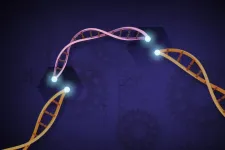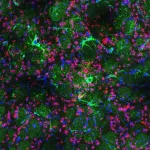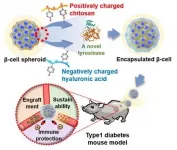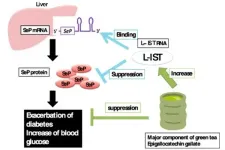UMD introduces new CRISPR 3.0 system for highly efficient gene activation in plants
Multiplexed gene activation system allows for four to six times the activation capacity of current CRISPR technology, with simultaneous activation of up to seven genes at once
2021-06-24
(Press-News.org) In a study in Nature Plants, Yiping Qi, associate professor of Plant Science at the University of Maryland (UMD), introduces a new and improved CRISPR 3.0 system in plants, focusing on gene activation instead of traditional gene editing. This third generation CRISPR system focuses on multiplexed gene activation, meaning that it can boost the function of multiple genes simultaneously. According to the researchers, this system boasts four to six times the activation capacity of current state-of-the-art CRISPR technology, demonstrating high accuracy and efficiency in up to seven genes at once. While CRISPR is more often known for its gene editing capabilities that can knock out genes that are undesirable, activating genes to gain functionality is essential to creating better plants and crops for the future.
"While my lab has produced systems for simultaneous gene editing [multiplexed editing] before, editing is mostly about generating loss of function to improve the crop," explains Qi. "But if you think about it, that strategy is finite, because there aren't endless genes that you can turn off and actually still gain something valuable. Logically, it is a very limited way to engineer and breed better traits, whereas the plant may have already evolved to have different pathways, defense mechanisms, and traits that just need a boost. Through activation, you can really uplift pathways or enhance existing capacity, even achieve a novel function. Instead of shutting things down, you can take advantage of the functionality already there in the genome and enhance what you know is useful."
In his new paper, Qi and his team validated the CRISPR 3.0 system in rice, tomatoes, and Arabidopsis (the most popular model plant species, commonly known as rockcress). The team showed that you can simultaneously activate many kinds of genes, including faster flowering to speed up the breeding process. But this is just one of the many advantages of multiplexed activation, says Qi.
"Having a much more streamlined process for multiplexed activation can provide significant breakthroughs. For example, we look forward to using this technology to screen the genome more effectively and efficiently for genes that can help in the fight against climate change and global hunger. We can design, tailor, and track gene activation with this new system on a larger scale to screen for genes of importance, and that will be very enabling for discovery and translational science in plants."
Since CRISPR is usually thought of as "molecular scissors" that can cut DNA, this activation system uses deactivated CRISPR-Cas9 that can only bind. Without the ability to cut, the system can focus on recruiting activation proteins for specific genes of interest by binding to certain segments of DNA instead. Qi also tested his SpRY variant of CRISPR-Cas9 that greatly broadens the scope of what can be targeted for activation, as well as a deactivated form of his recent CRISPR-Cas12b system to show versatility across CRISPR systems. This shows the great potential of expanding for multiplexed activation, which can change the way genome engineering works.
"People always talk about how individuals have potential if you can nurture and promote their natural talents," says Qi. "This technology is exciting to me because we are promoting the same thing in plants - how can you promote their potential to help plants do more with their natural capabilities? That is what multiplexed gene activation can do, and it gives us so many new opportunities for crop breeding and enhancement."
INFORMATION:
This work is funded by the National Science Foundation, Award #1758745 and #2029889. This paper, entitled "CRISPR-Act3.0 for highly efficient multiplexed gene activation in plants," is published in Nature Plants, DOI: 10.1038/s41477-021-00953-7.
[Attachments] See images for this press release:

ELSE PRESS RELEASES FROM THIS DATE:
2021-06-24
LA JOLLA--(June 24, 2021) When looking at a complex landscape, the eye needs to focus in on important details without losing the big picture--a charging lion in a jungle, for example. Now, a new study by Salk scientists shows how inhibitory neurons play a critical role in this process.
The study, published May 25, 2021, in the journal Cell Reports, shows that inhibitory neurons do more than just inhibit neuron activity like an off-switch; paradoxically, they actually increase the amount of information transmitted through the nervous system when it needs to be flexible. To make this possible, inhibitory neurons need to be integrated into the circuit in a specific way. These observations could help scientists better understand and treat disorders involving our ability to focus and modulate ...
2021-06-24
UNIVERSITY PARK, Pa. -- It can be difficult to get young kids to eat enough vegetables, but a new Penn State study found that simply adding more veggies to their plates resulted in children consuming more vegetables at the meal.
The researchers found that when they doubled the amount of corn and broccoli served at a meal -- from 60 to 120 grams -- the children ate 68% more of the veggies, or an additional 21 grams. Seasoning the vegetables with butter and salt, however, did not affect consumption.
The daily recommended amount of vegetables for kids is ...
2021-06-24
Rude behavior at work has come to be expected, like donuts in the breakroom. Two decades of research on employee relationships shows that 98 percent of employees experience rude behavior at work, but now a new study suggests a large majority of workplace relationships are not characterized by rudeness. Isolated incidents of rude behavior at work, although somewhat common, do not point to widespread incivility between employees and their colleagues, according to a new UCF study.
"Because prior research suggests workplace mistreatment is harmful and widespread, it is often called an epidemic, but our findings show that rude behavior is less like the flu and more like cholera," says Shannon Taylor, an associate professor of management and co-author of the ...
2021-06-24
Berlin and Bath, 24th June 2021 - Precision-fermentation company Formo and the University of Bath co-published the first large-scale study of consumer acceptance for animal-free dairy products.
Researchers surveyed 5,054 individuals from Brazil, Germany, India, the UK, and the USA to understand what consumers think of animal-free dairy products.
Precision fermentation is a process that allows specific proteins to be produced via microorganisms. By inserting a copied stretch of cow DNA, microorganisms produce milk proteins. The process is more efficient than using animals to make proteins and avoids the negative side effects of industrial animal agriculture, which is responsible for 18% of all greenhouse gas emissions.
The findings of the study, published in ...
2021-06-24
Leukemia is a group of blood cancers that affects thousands of people worldwide. However, with advances in medicine, several different types of leukemia can be effectively treated with donor stem cells through allogenic stem cell transplantation (allo-SCT). One such type of leukemia is B-cell acute lymphoblastic leukemia (B-ALL), which is caused by uncontrolled proliferation and prolonged existence of cancerous B-cells. While allo-SCT can 'cure' B-ALL in several cases, there are also cases of failure, characterized by deterioration in health after a period ...
2021-06-24
The brain is not a passive recipient of injury or disease. Research has shown that when neurons die and disrupt the natural flow of information they maintain with other neurons, the brain compensates by redirecting communications through other neuronal networks. This adjustment or rewiring continues until the damage goes beyond compensation.
This process of adjustment, a result of the brain's plasticity, or its ability to change or reorganize neural networks, occurs in neurodegenerative conditions such as Alzheimer's, Parkinson's and Huntington's disease (HD). As the conditions progress, many genes change the way they are normally expressed, turning some genes up and others down. The challenge for researchers like Dr. Juan Botas ...
2021-06-24
The central goal of cloud computing is to provide fast, easy-to-use computing and data storage services at a low cost. However, the cloud environment comes with data confidentiality risks attached.
Cryptography is the primary tool used to enhance the security of cloud computing. This mathematical technique protects the stored or transmitted data by encrypting it, so that it can only be understood by intended recipients. While there are many different encryption techniques, none are completely secure, and the search continues for new technologies that can counter the rising threats to data privacy and security.
In a recent study published in KeAi's International Journal of Intelligent Networks, a team of researchers from India and Yemen describe a novel, two-step cryptography ...
2021-06-24
A research team, led by Prof. Nathaniel S. Hwang and Prof. Byung-gee Kim, from Seoul National University (SNU) and Prof. Dong Yun Lee, from Hanyang University, has used enzymatic crosslinking to create nanofilms on cell surfaces. SNU has announced that it has developed a "cell caging" technology for the applications in cell-based therapies. The "cell caging" technique can prevent immune rejection during heterologous islet cell transplantation, facilitate smooth cell insulin secretion, and treat type 1 diabetic patients without immunosuppressants.
The research team succeeded in producing a nanofilm by using the electrostatic force to stack chitosan, which is a biological polymer, and hyaluronic acid in that order. To overcome the shortcomings ...
2021-06-24
Across the world, type 2 diabetes is on the rise. A research group has discovered a new gene that may hold the key to preventing and treating lifestyle related diseases such as type 2 diabetes.
The results of their research were published in the journal Nucleic Acids Research on June 18, 2021.
Selenoprotein P (SeP) is an essential plasma protein containing the micronutrient selenium. However, too much SeP spells trouble.
Excess SeP increases insulin resistance, thus weakening the effect of insulin, and worsening the metabolism of glucose.
"Excess SeP is the enemy when it comes to type 2 diabetes," stressed professor Yoshiro Saito from the Graduate School of Pharmaceutical Sciences at Tohoku University and co-author of the ...
2021-06-24
Female elephant seal weigh on average 350 kg, and dive continuously to the ocean's mesopelagic zone, about 200 to 1,000 meters deep, to consume their only prey: small fish that weigh less than 10 grams. Now, an international team of researchers, armed with eight years of data, may have answered a decades-long question: How do seals maintain their large size on such small prey?
They published their answer on May 12 in Science Advances.
"It is not easy to get fat," said paper author Taiki Adachi, research fellow with the National Institute of Polar Research and the School of Biology, University of St Andrews. "Elephant seals have to spend almost ...
LAST 30 PRESS RELEASES:
[Press-News.org] UMD introduces new CRISPR 3.0 system for highly efficient gene activation in plants
Multiplexed gene activation system allows for four to six times the activation capacity of current CRISPR technology, with simultaneous activation of up to seven genes at once







